This post is part of a larger deep dive
Curious about the role of Jung's dream theory and Jung's model of the psyche in Mulholland Drive? Check out Mulholland Drive Explained!
Or read the full Mulholland Drive article!
This post is part of a larger deep dive
Curious about the role of Jung's dream theory and Jung's model of the psyche in Mulholland Drive? Check out Mulholland Drive Explained!
Or read the full Mulholland Drive article!
Director: David Lynch
Producer: Mary Sweeney, Alain Sarde, Neal Edelstein, Michael Polaire, Tony Krantz
Writer: David Lynch
Starring: Naomi Watts, Laura Elena Harring, Justin Theroux
Year: 2001
Duration: 2h 27m
Country: U.S.A.
Language: English

Our rating

Your rating
It’s fair to say that Mulholland drive was the movie that not only changed my taste in art of any kind, but also very possibly my professional career. It was largely thanks to Mulholland Drive that I became interested in psychological thrillers, in particular those connected to the murky world of the subconscious mind. It turned out, this awakening was pivotal in choosing a profession as well.
I have to admit though, the first time I watched Mulholland Drive I was as fascinated as I felt stupid – I just didn’t get it! Thankfully, living in the Digital Age, a quick Internet search revealed numerous analyses of the movie that helped me appreciate the many subtle cues that abound in the movie. It gradually started to make sense.
If you strip away all the weirdness, the storyline of Mulholland Drive looks pretty elementary. I mean, here we have a girl, Betty, in her mid twenties moving to Hollywood with the aspiration to become a Hollywood actress.
She meets a woman, Rita, who is suffering from amnesia as a result of a car head-on collision. Betty befriends Rita and tries to help her find out about her seemingly shady past. In a separate story, a director called Adam is being bullied by an unnamed Organization into hiring an actress for the lead role in one of his movies. As we progress through the movie all three characters begin experiencing a series of bizarre and inexplicable events, which culminates in a story twist towards the end of the movie.
Nothing really exciting happens – there are no car chases, gunshot exchanges or jumping off cliffs. Yet, you can’t help but feel absorbed by the entire atmosphere; there is tension in literally every scene. Even the most mundane of behaviors, such as making a phone call, or walking down an alley, has a somehow edginess to it. Partly, this is due to the inclusion of just the right amount of cryptic events that make the movie weird but still largely coherent at the same time.
In my opinion, the ability to turn a seemingly simple narrative into a tale of eerie is one of David Lynch’s greatest qualities as a director. Even if you (like me) don’t get the movie the first time you watch it, by the time you finish it, you’ll beg for more.
The acting was superb. I knew little of Naomi Watts when I watched the movie back then, but I was positively impressed with what she managed to pull off.
I’m not an actor, but I don’t doubt that dual roles must be a tall order.
Yet, Naomi Watts played Betty/Diane as if she had been born for this role. I was captivated by the positivity and tenacity of Betty, whilst I pitied a troubled Diane.
Likewise, Justin Theroux was a pure joy to watch. My impression was that Justin needed not even memorize his scripts. It’s as if the cameras weren’t really there and he were simply going on with his life, and it happened to be a David Lynch’s movie.
And we mustn’t forget the soundtrack: every director knows that music is paramount to create that mystery and suspense that hook viewers to the screen, and Lynch surely knows how to hit the spot.
From the ominous score as Diane and Camilla walk up to the party house, to the poignant song of Rebekah Del Rio, every tune seemed to have been opportunely planned.
The same could be said of film production. Lynch had already given us a taste of his unorthodox film-making style (e.g., Twin Peaks, Blue Velvet), and we can definitely see the resemblance here.
Camera work, lighting and color blend in such a way, that the entire film has a kind of a dreamlike (or rather “nightmarish”) ambience.
Frankly, I cannot think how the film could be improved. I have probably watched it dozens of times and it never gets boring. Therefore, I am giving this cinematographic masterpiece a well-deserved rating of 5 stars.
As with most of Lynch’s films, Mulholland Drive is clearly on the weird spectrum. However, the weird elements in the film are so brilliantly incorporated into the narrative that they don’t become obtrusive.
Setting aside the pivotal story twist, there is a natural flow to the storyline, with only sporadic, although outright, bizarre scenes. For the most part, the narrative remains logical and you are able to follow the story without feeling totally perplexed. For this reason, Mulholland Drive receives a score of 3.5 in the Bizarrometer.
There are many interpretations for the main theme of the film, such as parallel universes to making deals with the devil (check this excellent source for copious interesting interpretations).
In this article, I will focus on the interpretation which I believe makes most sense. The idea is essentially this: the film can be divided into two parts; the first part we are viewing Diane’s dream – one in which she is a successful, kind and intrepid actress.
In the second part of the film, we witness Diane’s real life as a struggling and troubled actress. This divide is so obvious that you will notice when the jump from dreaming to reality occurs (see table below).
| Start scene | End scene | Movie order | Actual order |
|---|---|---|---|
| Pillow getting gradually blurry | Cowboy saying "Hey pretty girl! Time to wake up!" | 1 | 3 |
| Diane waking up and talking to her neighbour | Diane makes coffee and walks towards the sofa | 2 | 4 |
| Diane and Camilla making out on the sofa | Adam proposes to Camilla at the dinner party | 3 | 1 |
| Diane meets hitman at Winkies | Diane receives the blue key | 4 | 2 |
| Diane sitting on the sofa and staring at the blue key | Diane commits suicide | 5 | 5 |
There are many references to dreams in the film to suggest that this interpretation may have its merits. Here are a few examples:
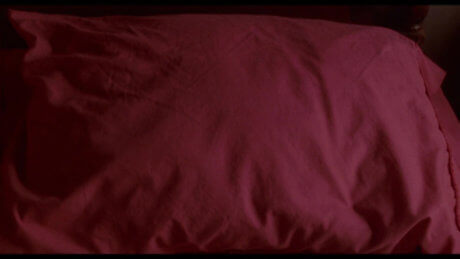
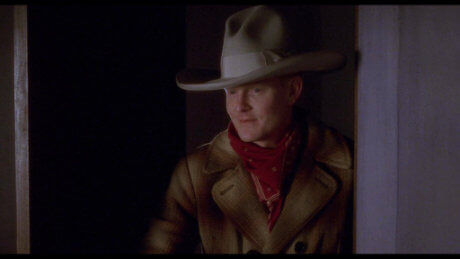
1. The most telltale clue that we are witnessing Diane’s dream happens right at the beginning of the film, when we see an image of a pillow getting gradually blurred. It is likely that this represents Diane going to sleep, and what we see from then on is actually Diane’s dream. Notice how the walls are similar to those in Diane’s flat at the end of the film. The last twenty minutes or so, we are seeing Diane’s real life. This is also suggested by the cowboy saying: “Hey pretty girl! Time to wake up!”, with Diane waking up to the sound of the door bang.
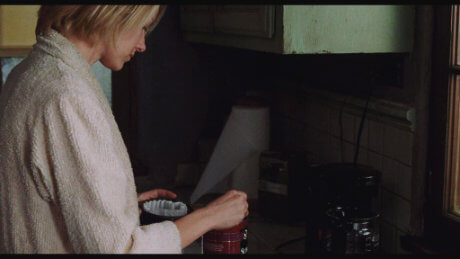
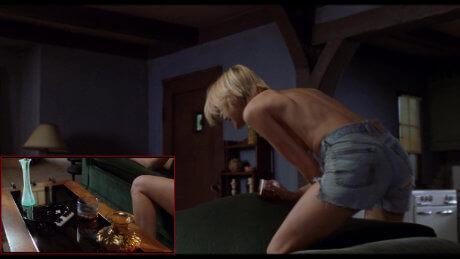
2. If you re-order the sections of the film according to the purportedly “logical” chronology, you will notice that the order of events matches what you would expect if the first part of the film were a dream (see table above). After Diane wakes up and finishes making coffee she is wearing a dressing gown. You should also notice that the blue key that the hitman had given Diane at Winkie’s is on the table. However, a few moments later, we see Camilla lying on the sofa and Diane is wearing shorts. The blue key is not on the table any more (see the inset on the right picture above). So everything happening just after Diane and Camilla make out on the sofa, until the restaurant scene happens before Diane’s dream. The dream takes place after the hitman delivers the key to Diane. This makes sense: Diane could only have dreamed of the characters in the dream (e.g., Coco, the Cowboy, the waitress Betty, the guy at the Winkie’s counter) after she encountered them in real life.
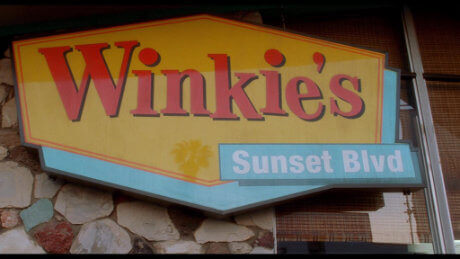
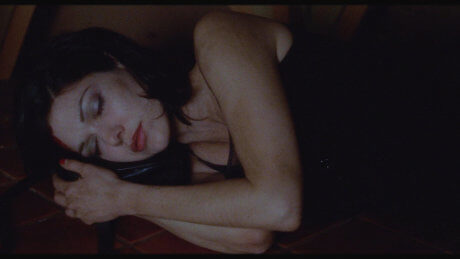
3. Winkie’s scene: This scene is completely different from the rest of the film, and I couldn’t find any satisfactory interpretation of it. Here, there is a conversation between two men in the Winkie’s diner, which is the place Diane and the hitman meet. There are some interesting clues here, however, that might suggest we are in a dream. First, just before the Winkie’s scene, Rita falls asleep, and the Winkie’s scene with the two men develops. Straight after one of the men has a heart-attack, we see, for a split second, Rita still sleeping. Could this indicate that this scene is actually Rita’s dream? Perhaps this is a subtle clue David Lynch used to define the time frame of Rita’s dream. There’s more. One of the guys at Winkies says that it’s the second dream he’s had, but they are both the same – could the Winkie’s scene be a dream inside of a dream? As we will see later, they are both the same because Rita is simply a part of Diane’s personality – so it’s really the dream of the same person (i.e., Diane).
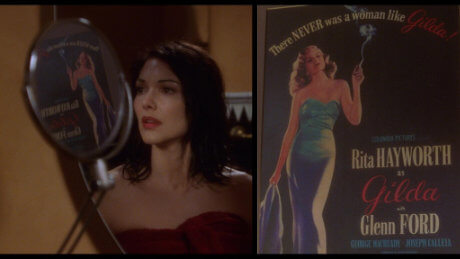
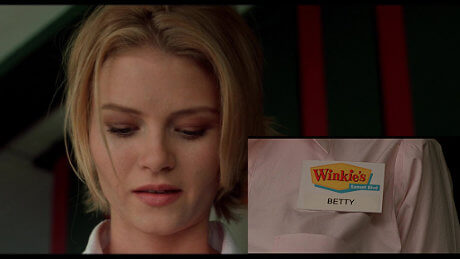
4. All characters that appear in Diane’s dream were individuals that Diane either already knew (e.g., Rita) or just met (e.g., the waitress called Betty) before the dream took place. However, most of the characters were given different names than their actual names (this is what psychoanalysts call displacement, and is a core characteristic of dreams).
Admittedly, none of these reasons prove that the film is about Diane’s dream, or that any dreaming occurs at all for that matter. This is, however, the classical interpretation of the film, and the one that makes most sense to me.
So, let me share with you one interesting theory put forth by Psychoanalyst Carl Jung, that attempts to explain why dreams exist and are so strange. Perhaps you can then judge for yourself the merit of our interpretation.
The Castigliane brother and the espresso
In the dream, Adam meets the Castigliane brothers, the two agents who order him to cast Camilla Rhodes for the leading role in his movie. One of the brothers tries an espresso, which he finds atrocious.
Diane spots this dream character at the dinner party while she is drinking an espresso herself. What’s more, a few minutes earlier, Camilla is heard saying “Yo nunca fue a Casablanca con Luigi“. Well, the name of the Castigliane brother that tried the espresso is Luigi Castigliane.
This suggests that Diane’s brain has fused these different elements (i.e., the sight of the man, the espresso, and the name Luigi) to concoct that scene in the dream. Because that dinner party turned out to be an emotional catastrophe for Diane, in the dream this negative emotional charge is released, as witnessed when the Castigliane brother spits out the espresso, and his sibling growls with fury.
Coco
Coco says exactly the same thing “Just call me Coco. Everybody does.” to Diane as she says to Betty in the dream. We all know from self-experience that the same expressions we use or hear in our daily life are often replayed in our dreams. Many of such repeated phrases abound in the movie.
Blue key
The blue key that Betty finds in her purse appears to be a sort of transformed version of the key the hitman gives Diane.
I have seen many interpretations about what the key could open, but my take on it is that the key doesn’t open anything at all. It is simply a code that the hitman uses to let Diane know that the hit took place. That’s why he laughs when Diane naively asks him what it opens – she is thinking about the key too literally.
In contrast, the blue key in Diane’s dream is full of symbolism. It opens a box that contains a void; this void could represent Diane’s unconscious.
The submerging into the void as the result of Rita opening the box may symbolize the transition from dream to reality, as it is at that point that Diane wakes up.
In a sense, the blue key that the hitman gives Diane kind of symbolises a transition as well. It represents the moment of Diane’s awareness that Camilla is now dead.
Adam and the pool man
At the dinner party, Adam is heard saying “So I got the pool and she got the pool man”. In the dream, Adam actually finds, to his chagrin, that his wife is cheating on him with a pool man. So Diane’s brain has altered the actual events in the dream, and this could indicate her wish to see Adam humiliated.
Bob Brooker: the director of “Sylvia North Story”
During the dinner party, Diane confesses she had been turned down the main role for a movie called “Sylvia North Story”, which she wanted really bad.
Diane also reveals that the director of the movie (a so-called Bob Brooker) did not think much of her, and gave the part to Camilla instead.
It is therefore interesting to see that during the acting scene in the dream, Bob Brooker is portrayed to be a seemingly inept director. Betty’s performance in the audition was flawless but the director appears confused and unsure what to say.
Again, this may indicate that Diane’s brain is attempting to fulfill a (perhaps unconscious) wish to ridicule the director towards whom she probably feels resentful.
I am particularly interested in what you’ve said about the ‘Organization’ as Diane’s Animus. It especially makes sense if Diane’s condition (illness?) is partly due to her having a ‘fragmented’ Animus – after all, the organization consists of several discreet entities, as you’ve described it.
The way I read Jung, the Animus normally consists of a series of male figures, each existing alone during the stage of animus development in which it corresponds. In Diane’s case, with more than one figure coexisting, perhaps the ‘Cowboy’ figure is a holdover from an earlier stage of Diane’s Animus, the cowboy representing a kind of primitive or ‘base’ male.
Hi Arlen! Great comment, many thanks!
I think your reading of Jung’s Animus is spot on. However, my understanding is that the Animus can appear as different male figures in dreams (even within the same dream). Jung mentions that the type of male figure will depend on the stage of development as you wrote, but it seems there’s no constraint on the number of dream figures that can appear, so long as they all represent that particular Animus stage (for example, a first-stage Animus can appear as Tarzan and then later as Superman in the same dream; but I’d say Tarzan and Gandhi in the same dream would be unlikely).
You do make a very interesting point that the Cowboy may have a prominent role in Diane’s psyche. This is consistent with him being the initiator as well as terminator of Diane’s dream, since he shows up shortly after Diane starts dreaming, and is the cause for her waking up from the dream (when he says: “Hey pretty girl! Time to wake up!”).
One important flaw in my interpretation is that I analysed Diane’s Animus as if she were straight, when in fact Diane is lesbian. Alas, Jung says little about Animus/Anima in same-sex relationships, so I decided to omit this point from my analysis. However, it would be interesting to discuss it further although I think that discussion will be more appropriate for the forum. If you like, you can start a new thread here, and I’ll be happy to dig up on this.
Hi mindbent, and thanks for clearing that up! I tried to make a new post just now at the link you provided, but I can’t tell if the post took or not. (I think I might have corrupted the block ‘footer,)
Hi Arlen
I’m very sorry but I can’t find your post anywhere in the website so probably it didn’t go through.
I performed a few tests just to ensure that the posts are shown and it seems to be working, so would you mind submitting your forum post here again please?
Thank you very much for your patience!
Hi mindbent,
I Just made another comment and it’s showing. Thanks for all your help with this.
For anyone interested, here is the link to the forum thread.
Masterpiece
None
None